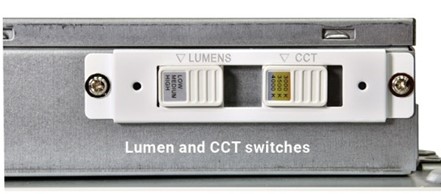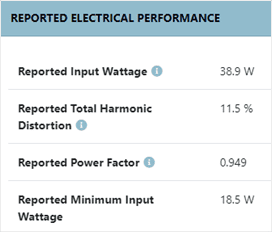This website uses cookies so that we can provide you with the best user experience possible. Cookie information is stored in your browser and performs functions such as recognising you when you return to our website and helping our team to understand which sections of the website you find most interesting and useful.

By Dan Mellinger, Principal at Energy Futures Group
No two projects are the same, and anyone who has ever worked on a lighting project certainly knows this to be true. Building characteristics, lighting design objectives, and customer preferences can vary considerably from one project to the next. Lighting manufacturers address this challenge by producing a wide array of product configurations to serve every need. The consequence of all these product combinations is a complicated supply chain with physical limits to which products can be held in inventory. What if there was an easier way?
Well, there is. Field-adjustable lighting, also known as field-selectable lighting, is a feature that allows installers to conveniently select from different pre-set lumen output and/or color (CCT) settings at the time of installation. Similarly, field-adjustable light distribution (FALD) products allow the angle of light distribution to be easily altered on site using either internal components or accessories that are included in the shipped product (FALD will not be the focus of this blog). These innovations allow a manufacturer to serve a wider range of projects and applications with the same product. For example, a product with three selectable lumen outputs and three selectable color temperatures can take the place of nine different product configurations. As a result, the number of product SKUs can be significantly reduced, which consolidates manufacturing and inventory. Manufacturers and distributors can more efficiently utilize their limited warehouse space, and installers benefit by gaining flexibility to achieve customer objectives for energy efficiency, light output and/or color temperature. If the new lighting is too bright, or the customer prefers a different color temperature, contractors merely need to flip a switch to make the adjustment.
Not surprisingly, the use and relevancy of these products within the industry is increasing. According to industry journalist Craig DiLouie, writing for tED Magazine (March 2022):
“On the luminaire side, adjustability started with lower-wattage products such as downlights, troffers, and panels and has since moved into other categories including high-bays and undercabinet luminaires. While predominant for indoor lighting, the adjustability trend has begun to enter outdoor categories such as floodlights, wall packs, and area lighting.”
Mr. DiLouie went on to quote Eric Jerger, VP and GM of Business Segments and Customer Experience at Cooper Lighting Solutions in saying:
“The demand for field-adjustable luminaires continues to grow as distributors are maximizing limited warehouse space. Field-selectable luminaires offer multiple products in one, saving distributors money by stocking less inventory while still being able to meet the needs of their customers.”
Field-adjustable light output, or FALO, and white-tunable products have been accepted under the DLC Solid State Lighting (SSL) Qualified Products List (QPL) since 2018. As of April 2023, the SSL v5.1 QPL includes over 50,000 FALO products and over 12,000 white-tunable products. With so many qualified products, and the numerous aforementioned benefits, you might think that energy efficiency programs have embraced field-adjustable products as the wave of the future. That’s where the picture becomes decidedly murky.
Field-adjustability, and specifically FALO, represents uncertainty to utility energy efficiency program designers and evaluators. These programs have the responsibility of estimating energy savings for the project, but if a product can be installed at various levels of light output (and wattage), what setting does the utility use for savings claims?
The DLC Testing and Reporting Requirements for Field-Adjustable Light Output Products defines FALO as:
A dimming type where products are capable of being adjusted to decrease or increase lumen output and wattage from the default setting. The default setting is defined as the setting at which the product emerges from production and is shipped with no adjustments to lumen output. The field-adjustable set point is fixed by the manufacturer, distributor, installer, or commissioning agent before or during installation or commissioning, via a control that is made discrete to that purpose via a proprietary process or separate control (i.e. not part of a regular occupant- or sensor-facing control system). Typically, the field-adjustable light output settings are not intended to be occupant interfacing.
The field-adjustable selection is often made by a mechanical switch or dial on the product and, when installed, is not accessible by the end user, such as the switch shown in the following image.

Unlike manual dimming and high-end trim, which are also used to adjust the light output to something less than maximum, FALO is typically set once by an installer and can’t easily be reconfigured. All three approaches – manual dimming, high-end trim, and FALO – affect the light output of a luminaire, but there are key differences between each strategy as outlined in the table below.

Utility energy efficiency programs calculate and claim the energy savings for these strategies differently. Manual dimming and high-end trim are often included in the savings assumption for a lighting control system, such as Networked Lighting Controls. Or, if treated as an independent strategy, a % savings value is defined and applied against the LED installed wattage. For example, high-end trim may be assumed to save 15% of the total (uncontrolled) LED wattage. Assumptions like these are often based on thorough studies such as the DLC/NEEA report Energy Savings from Networked Lighting Control (NLC) Systems with and without LLLC.
In the case of field-adjustable light output, there haven’t been any studies or evaluations to examine how installed settings vary from the maximum output. Because of this, and since efficiency programs take care to avoid over estimating savings, FALO products are often assumed to operate at their highest wattage setting. An informal survey of eight DLC member programs confirmed this belief. 100% of the programs responded that they use the input wattage reported on the QPL (which, for FALO products, represents maximum output). This is true for programs where there is limited interaction with customers, such as midstream or prescriptive. When a utility is more involved on a project, such as on custom projects, the actual input wattage is used. Notably, a much higher volume of products and rebates flow through midstream and prescriptive programs compared to custom.
The ramifications of assuming full wattage are that efficiency programs may be under-claiming savings when FALO products are used (and therefore achieving less toward their goals) and customers may not be maximizing their rebate potential. Consider the following analysis of the FALO products listed on the QPL. On average, troffers can be field adjusted to operate at 64% of maximum output. The high-bay products can be adjusted down to 32% of maximum output, on average. And outdoor product categories have an average low setting that is 30-36% of the maximum. Since these QPL figures are averages, individual products will be capable of achieving minimum settings even lower. Of course, not all products will be set to these minimum levels, but any setting less than 100% represents savings that go unrealized by a utility program.

So, what is an energy efficiency program to do? A variety of options and approaches are described below for program administrators to consider when calculating the savings from FALO products.
- Use the actual installed wattage whenever possible. Doing so will only be feasible for lower volume downstream programs like custom and some prescriptive. Program administrators could implement a reporting process for contractors and customers to provide the actual installed setting when FALO products are used. If possible, keep a record of installed vs. maximum wattage on FALO projects to help support assumptions used in other programs.
- Use the median value between the QPL reported input wattage and the FALO reported minimum input wattage. For example, in the QPL listing shown below, the median value would be 28.7 watts (halfway between 18.5 and 38.9 watts). Compared to the reported input wattage, the median value represents a savings of 26%. This approach assumes that FALO products are installed, on average, using a mid-point setting for light output. An energy efficiency program could choose to take a more conservative approach, such as the 75th percentile between the FALO reported minimum wattage and the QPL reported input wattage.

- Develop deemed savings values specific to FALO products. This strategy could be employed for high volume / low-touch programs like midstream, where efficiency programs use assumptions rather than actual project data. Each product type could have FALO and non-FALO deemed values, based on QPL data. Such deemed values could easily be developed based on averages among FALO products listed on the QPL.
- Apply a savings factor whenever FALO products are used. This approach is consistent with the way energy efficiency programs treat dimming, high-end trim, and other lighting control strategies. Lacking a study to support this factor, an estimate would be necessary for the % reduction relative to maximum output. If the median point was assumed, savings factors would be in the range of 17-35% as shown in the following table.

As field-adjustable products become more pervasive in the lighting industry, representing a growing share of sales volume, it will be increasingly important for energy efficiency programs to adequately account for the installed wattage of these products.
Finally, there is an opportunity for manufacturers to adjust their approach to FALO for the benefit of their customers and energy efficiency programs. FALO products are most often shipped with the default setting being at the maximum output. This is evident based on the QPL data, where the default input wattage is equal to the maximum wattage on 94% of listed products. If manufacturers adopted a standard practice of shipping FALO products with a default setting at or near the mid-point of the selectable light output options (such as 85% for indoor troffers and linear ambient), contractors may be more likely to use a less-than-maximum setting, thus yielding energy savings for customers. For any additional questions regarding FALO products, please contact info@designlights.org.
© 2023 DesignLights Consortium. The DesignLights Consortium is a project of Efficiency Forward, Inc., a non-profit 501(c)3 organization. Privacy Policy Terms of Use
